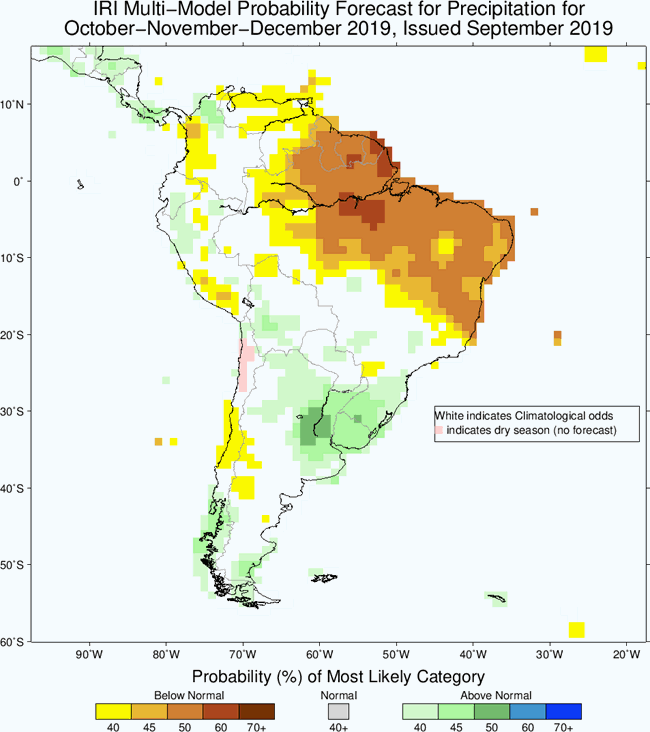| October 4, 2019 | No.126 |
September 2019
(Back Issues Here)
September 2019 brought more rain to the Palmira Arriba Station. The reports from around the District of Boquete for September vary but indicate more normal levels of rain this month.
Rainfall for
September 2019 |
|||
Area |
Contributors |
September |
Total 2019 |
El Santuario |
Terry Zach |
5.15 | 53.63 |
Jaramillo Arriba |
Steve Sarner |
19.32 | 77.67 |
Jaramillo Abajo |
Don Berkowitz |
26.42 | 100.45 |
Jaramillo Abajo |
Bobi McGann |
23.97 | 88.18 |
El Salto Arriba |
Rodrigo Marciacq |
14.02 | 59.05 |
| Valle Escondido | Doug Remsen | 13.07 | n/a |
Brisas Boquetenas |
Austin Perry |
28.00 | 102.45 |
| Brisas Boquetenas | Richard Sturtz | n/a | n/a |
Los Molinos |
Sela Burkholder |
21.63 | 106.85 |
| Los Molinos | Fred Donelson | 17.01 | 95.33 |
Santa Lucia |
Paula Litt |
20.66 | 75.12 |
Lucero (Cielo Paraiso) |
Michael Mullin |
34.63 | 112.82 |
Cerro Verde |
Charlotte Lintz |
6.18 | 55.40 |
Boquete Country Club |
Paul Arrandale |
28.47 | 89.40 |
Palmira Abajo |
Betty Gray |
28.81 | 69.83 |
Palmira Arriba |
Lloyd Cripe |
22.56 |
72.56 |
n/a = not currently available but will be posted when available |
|||
Welcome to Doug Remsen in Valle Escondido (Bajo Boquete) who is now measuring rainfall and reporting it to us. Thanks again to all the volunteer rainfall data collectors. We appreciate your help to better understand micro rain climates in the Boquete District.
The monthly rainfall at the Palmira Arriba station was 22.56 inches. Compared to the data for 13 previous years at our station, this month's rainfall is average. The mean/average for September is 21.62 inches with a standard deviation of 10.36 inches. The range is 9.30 to 46.00 inches. Check out the data over the past years. You can also look at the tables in the Climate Section to see what rains we have had in the month of September over the years.
The highest rainfall reported for September was 34.63 inches at Lucero (Michael Mullin) and the lowest was 5.15 inches at El Santuario (Terry Zach).
Last month I mentioned that the temperature was lower than normal. Well, the truth came out! The temperature sensor in the station was failing. A new sensor is enroute and I hope to shimmy up the 20 foot pole and put it in this weekend. I put a notice at the website to not rely on the temperature measurement for the last 3 months and the current measure until I install a new sensor. In case you missed it below the display on the Quick page it says: "THE TEMPERATURE SENSOR HAS FAILED. PLEASE DISREGARD THE TEMPERATURE UNTIL THIS MESSAGE IS TAKEN DOWN."
Such is life. Mechanical/electronic things break down and need maintenance. This is why it is important to buy good equipment that does the job well and has good maintenance support. You can then rely on the equipment, monitor it and make repairs as needed. The WeatherHawk weather station is of good quality and the company offers good technical support with available replacement parts. Since 2006 there have been a variety of needs for repair of the station and the company has always been very supportive. I highly recommend this company if you want to be serious about collecting reliable weather data and make repairs as needed.
The latest ENSO Cycle Report is now saying that "ENSO-neutral conditions are present. Equatorial sea surface temperatures (SSTs) are above average across the western and central Pacific Ocean and are below average in the eastern Pacific. The pattern of anomalous convection and winds are generally consistent with ENSO-neutral. ENSO-neutral is favored during the Northern Hemisphere fall 2019 (~75% chance), continuing through spring 2020 (55-60% chance)."
Here is a link to an excellent source for understanding El Niño. Give it a read and you will learn a lot about this important weather phenomenon.
The IRI (International Research Institute for Climate and Society) (select South America from the Region menu) is reporting the following precipitation predictions for the months of October-November-December of 2019. Note the predictions of above normal precipitation for most of Panama (green).

ETESA's, hydrology and meteorology section is predicting that Chiriqui will have varying levels of precipitation between normal and below normal in October, November and December of 2019. You can read their report and check out the details in the "documents" section at this link.
Those who have been following my reports over the years are aware that I often recommend articles about severe tropical weather written by Dr. Jeff Masters at Weather Underground. He is highly experienced and has written a plethora of very informative articles over the years helping us better understand more severe weather. After writing over 3000 articles over a span of 14 years, he is now retiring from Weather Underground. He will however be writing a blog called "Eye of the Storm: the Science Behind Extreme Weather" for Scientific American. He expects to write about 50 blogs a year. Dr. Masters was a co-founder of Weather Underground 24 years ago. You can read more about him and his retirement at this link. I will personally miss his articles at Weather Underground and plan to follow his Scientific American Blog. Fortunately, Bod Hensen will continue the blog at Weather Underground and provide ongoing information.
We are now into October which is often the rainiest month of the rainy season. This is the month for which umbrellas were invented. Be prepared for grey skies and some real drenching. And don't forget that the reason things are so green here in Paradise is because of the rain. Also the rain is why they call this the Rain Forrest. Smile and be grateful!
Lloyd Cripe
